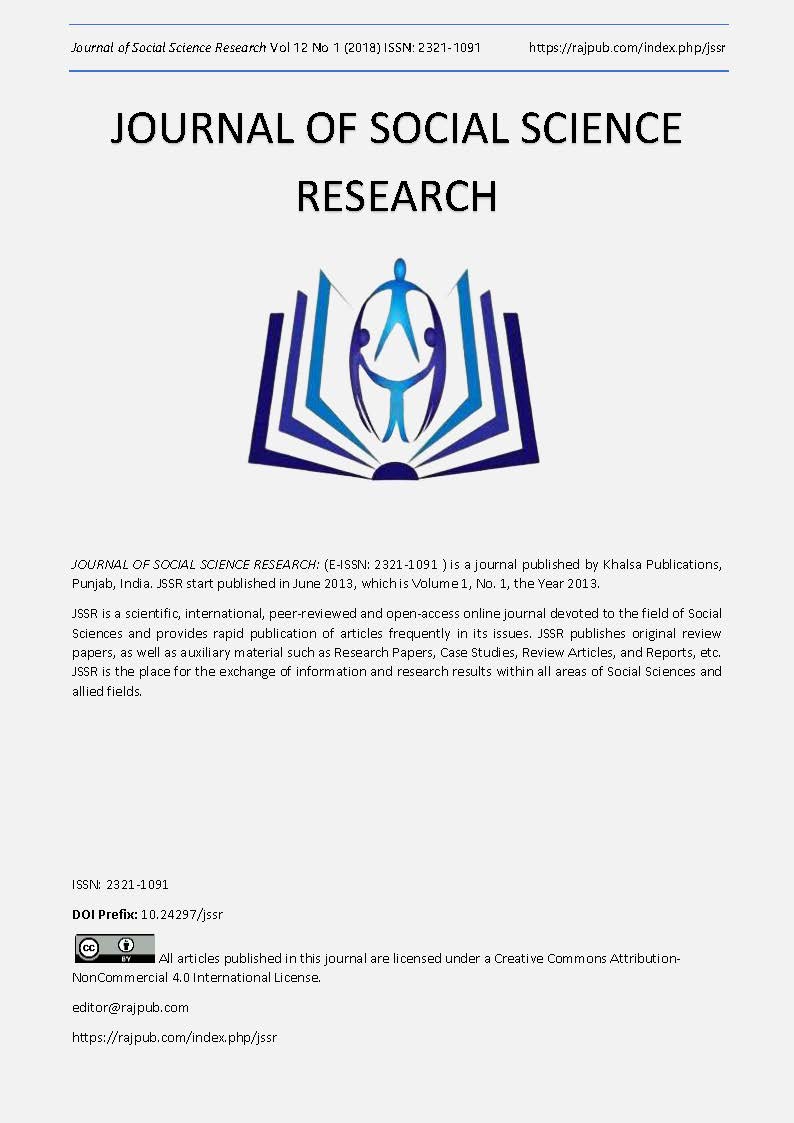Assessment of Extension Services Delivery to Fish Farmers in South Western Nigeria
DOI:
https://doi.org/10.24297/jssr.v12i1.7193Keywords:
Extension deliver, Agricultural Information, Fish Farming and Information UtilizationAbstract
Inability of fish farmers in Nigeria to produce at a rate that can meet the population demand has been linked to lack of access to crucial information on improved fish farming technique. Information is an indispensable factor in fish farming and it is the basis of extension service delivery. This study was designed to describe demographic characteristic of fish farmers, identify sources of various information to fish farmers and identify information access constraints faced by farmers. Purposive sampling procedure was used to select 2 States and a total of 160 respondents were selected for the study. Descriptive statistics such as frequency, percentage, mean and standard deviation and Chi-Square (X2) was used for inferential statistics. Result revealed that mean age was 44.8 years, 77.5% were male, only 7.5% have no formal education and 98.1% were full time fish farmers. About 25.0% received information frequently, 50.6% rarely while 24.4% never received information from extension agents. Inadequate of extension contact was identified by 88.8% of the respondents as information access constraint. Chi-Square analysis showed significant relationship (X2 = 13.426, p = 0.016) between source of information and utilization of information.
Downloads
References
2. Adekoya, B. and Miller, J. W. (2004). “Fish Cage Culture in Nigeria: An overviewâ€. National Culture Agriculture Focus, 1(5): 1-10
3. Adereti, F.O., Fapojuwo, O. E. and Onasanya, A.S. (2006) “Information Utilization on Cocoa Production Techniques by Framers in Oluyole Local Government Area of Oyo State, Nigeriaâ€, European Journal of Social Science, Vol. 3 (1) pp. 1-7.
4. Ajana, A. M. (2002) “Overview of highlight and problems of fisheries extension in Nigeria Agricultureâ€, Nigeria’s Pioneer Agriculture News Reporting and Trade Promotion Magazine, Vol. 4 (1): pp. 27-32.
5. Amiengheme, P. (2005). “The important of Fish in Human Nutrition.†A paper delivered at a Fish Culture Forum, Federal Department of Agriculture and Natural resources, Abuja, Nigeria, 2005.
6. Budak, D. B., Budak, F. and Kacira, O.O, (2010). “Livestock Producers’ Needs and Willingness to pay for Extension service in Adana Province of Turkeyâ€. African Journal of Agricultural Research, 5(11): 1187-1190
7. CBN (2005). “Central Bank of Nigeria Annual report and Statement of Accountâ€.
8. CBN (2010). “Central Bank of Nigeria Annual Report for the Year Ended 31st December, 2010â€. Pg.251.
9. Esobhawan, A.O. (2007). “Efficiency Analysis of Artisanal Fishery Production in Edo State, Nigeriaâ€. Ph. D Thesis Submitted to Department of Agriculture Economics and Extension, Ambrose Alli University, Ekpoma, Nigeria.
10. Esobhawan, A.O., Erie, G.O., Osasogie, D.I, Osifo, A.A and Ogundele, S.L. (2011).
“Econometric Analysis of the performance of the Fisheries Subsector in the Nigeria Economy from 1970 to 2008: A Structural Analysis Approachâ€. In: P.O. Erhabor, C.I Ada-Okungbowa, C.O. Emokaro and M.O Abiola (eds) From Farm to Table: Whither Nigeria. Proceedings of 12th Annual National Conference of National Association of Agricultural Economists (NAAE). Pp224-227.
11. FAO (2000) FAO Fishery Department Country Profile. Nigeria. FID/CP/NIR Rev. 4 March 2000 11pp.
12. Fasasi A. T. (2003) Kenynote address of the programme manager of the Ogun state Agriculture Development Programme (OGADEP), Abeokuta at the 1st Annual Fish Farmer seminar and Training Workshop organized by Fisheries Society of Nigeria (Ogun State Chapter) at OGADEP Abeokuta on July 31st 2003. 6pp.
13. Food and Agriculture Organization (2005). “Nutritional Benefits of Fishâ€. Retrieved on October 2, 2011 from w.fao.org/docrep/168.
14. GreenFacts (2004). “World Fisheries Productionâ€. www.greenfacts.org/fisheries/04-utilization.htm. Retrieved on January 13, 2006.
15. Obiekezie, A.I. (1999). “Poverty Alleviation through Fisheries Production: The Way Forward’. Paper presented at the Annual Zonal Workshop of the Research-Farmer-Input-Linkage System, Umudike, Nigeria.
16. Rivera, W.M. Cary, J.W. (1997). “Privatizing Agricultural Extensionâ€. In: Swanson, B.E., Bentz, R.P. and Sofranko, J.A. (Eds), Improving Agricultural Extension: A Reference Manual. Rome: FAO, pp.203-211.
17. Satia, B. P. (1990) “National Reviews for aquaculture Development in Africaâ€, 29 FAO Fisheries Circular, No.770.29. Rome, FAO. 193pp.
18. Shekara, P.C. (2004). “Status of Private Extension in Indiaâ€. Accessed on 27/11/2012 from http://www.manage.gov.in/pvtext/pvtExt.htm.
19. Tobor. J. G. (1992) “The Fishing Industry in Nigeria. Status and Potential for self-sufficiency in fish productionâ€, NIOMR Tech. Paper No 54.
20. World Commission on Environment and Development (WCED) (1987). Our Common Future. New York: Oxford University Press.
Downloads
Published
How to Cite
Issue
Section
License
 All articles published in Journal of Advances in Linguistics are licensed under a Creative Commons Attribution 4.0 International License.
All articles published in Journal of Advances in Linguistics are licensed under a Creative Commons Attribution 4.0 International License.




